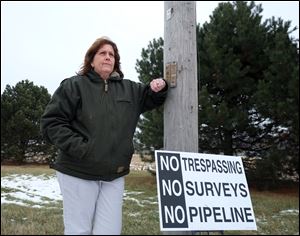
NEXUS GAS TRANSMISSION
Pipeline may ruin residents’ wells, health officials say
5/2/2015
Some residents are concerned over a proposed pipeline.
Thousands of Lucas, Fulton, and Henry County residents could have their water wells polluted by the proposed NEXUS Gas Transmission pipeline if it is not rerouted away from the highly sensitive Oak Openings region and its extremely porous sand-based aquifers, according to the Fulton County Board of Health.
The health board submitted a letter Thursday to the Federal Energy Regulatory Commission saying that while it recognizes pipelines “are necessary to transport Ohio’s energy to market,” it also said the industry’s typical safeguards aren’t enough for the Oak Openings region.
A globally rare oak savanna region that is a remnant of the Great Lakes region’s glacial era, the Oak Openings region has soft sand aquifers with pristine water that are highly vulnerable to contamination with any disturbance.
They don’t offer the same protection as buffers made of clay, shale, and other hard materials, Kim Cupp, Fulton County health commissioner, told The Blade.
She said the solution is not simply drilling deeper for water. In some areas, there could be less water. In others, there are pockets of naturally occurring hydrogen sulfide gas that would give the well water a foul, rotten-egg smell and taste, she said.
“The risk of permanent contamination and short-term dewatering of this vital aquifer is significant and avoidable,” the county health board said in its FERC letter.
The water table is so high in those aquifers it is at or above the surface in some areas, the county health board said.
“The vehicles that will be used to install the pipeline have the potential to introduce contaminants directly to the aquifer such as diesel fuel, gasoline, hydraulic liquids, and other potential contaminants present in the construction phase,” the letter said, adding that the required dewatering phase of construction could deplete wells.
In a related matter, the Fulton County Board of County Commissioners this week filed with FERC a copy of a resolution the county board passed on April 21 stating that it will “refrain from authorizing or taking any actions that would facilitate or otherwise be supportive of the construction of the Nexus gas transmission pipeline and Rover pipelines within the limits of Fulton County, Ohio, without proper dialogue with landowners.”
The proposed Rover LLC pipeline is an $4.3 billion, 820-mile project that Texas-based Energy Transfer Partners wants to have come through Fulton, Defiance, Henry, Wood, Hancock, and Seneca counties before cutting across Lenawee County and other parts of southern Michigan and into southwestern Ontario.
Arthur Diestel, NEXUS spokesman, reiterated past statements that the company will do all it can to prevent contamination.
He also reiterated that the final route has not been selected.
The proposed route is the subject of environmental scoping meetings the Federal Energy Regulatory Commission is now holding throughout the region, including three in this area next week.
Area meetings include one on Tuesday at Tecumseh Center for the Arts, 400 N. Maumee St., Tecumseh, Mich.; Wednesday at Swanton High School, 601 N. Main St., Swanton, and Thursday at Fremont Ross High School, 1100 North St., Fremont.
Each begins at 6 p.m.
The first three were in Grafton, Wadsworth, and Louisville, Ohio.
“The proposed NEXUS Gas Transmission pipeline will not contaminate drinking water or aquifers,” Mr. Diestel said in an email. “The pipeline will be constructed with high-strength steel with an epoxy coating, and the natural gas is transported in a gaseous state.”
Natural gas is lighter than air, which “means in the highly unlikely event that natural gas escapes from the pipeline, the gas can only travel up through the soil into the atmosphere where it dissipates,” Mr. Diestel said.
No toxins that would degrade water quality are released during construction or operation, he said.
Several area landowners who belong to CORN — the Coalition to Reroute NEXUS — said they plan to attend next week’s hearings. CORN was formally known as NAN, which stood for Neighbors Against NEXUS.
The project has received its criticism but also support from many key public officials, including Ohio House Majority Floor Leader Barbara Sears (R., Monclova Township), who said in a letter to FERC she considers the proposed NEXUS pipeline “a critical economic development and infrastructure project within Ohio that will bring vital new jobs to my district and new revenue to our county and school districts.”
“Our communities have a unique opportunity to play a role in moving Ohio and the nation towards energy independence as we continue to safely develop and transport abundant supplies of clean burning, low-cost natural gas,” she wrote.
Other letters of support on file include those from the Ohio Chamber of Commerce; the Erie County Commission; the International Union of Operating Engineers; U.S. Rep. Bob Gibbs, a Holmes County Republican, and the Ohio Gas Company.
Several property owners have filed letters of objection. The Ohio Department of Natural Resources, in an eight-page letter, notes the pipeline would cross the Maumee River, a state-designated scenic waterway, and would be built near several endangered and threatened species.
NEXUS is one of at least three major pipeline projects planned for northwest Ohio in coming years.
It would be a 250-mile pipeline across 11 northern Ohio counties and three in southeastern Michigan.
If approved, NEXUS Gas Transmission, a subsidiary of Houston-based Spectra Energy, would link existing structures to enable natural gas from southeast Ohio and southwest Pennsylvania to be pumped for decades into Canada via Michigan to a hub south of Sarnia, Ont., starting in late 2017.
Contact Tom Henry at: thenry@theblade.com, 419-724-6079, or via Twitter @ecowriterohio.